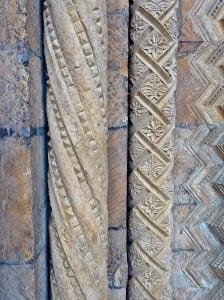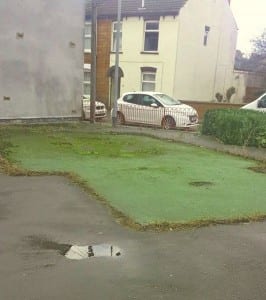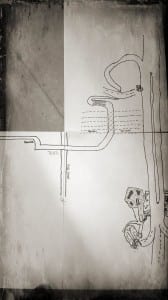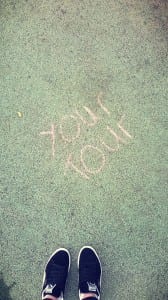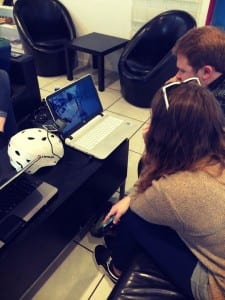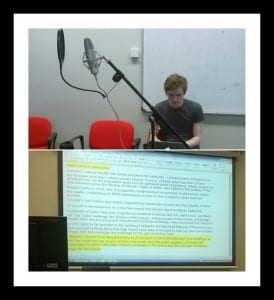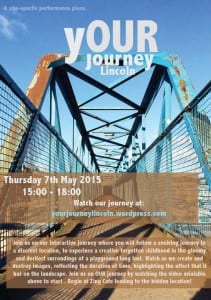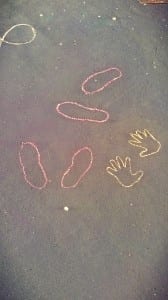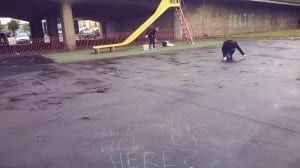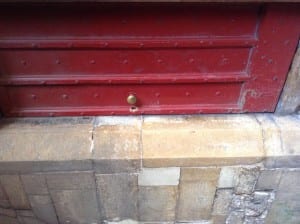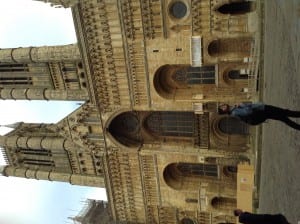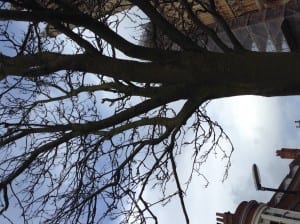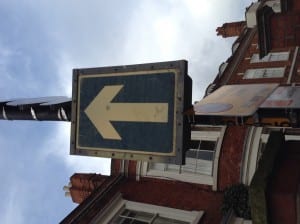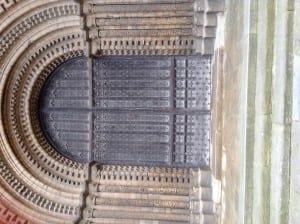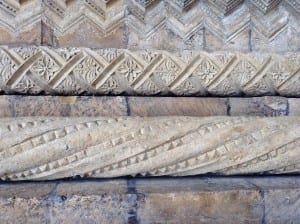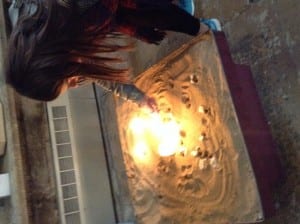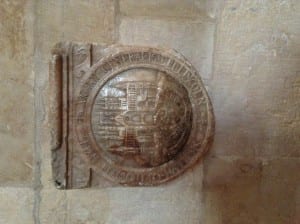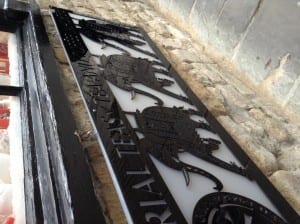Framing Statement
For our site specific module we were given the task to try and make an audio based performance for our audience, and to take the audience members on a ‘journey’ through the use of audio and imagination. We proceeded to call the performance ‘yOURJourney’ which would be performed on May 7th 2015.
Using the idea of a drift to see where it would take us, we wandered around Lincoln and ended up around the more industrial area of Lincoln, which made us think of the idea of growing up in Lincoln and how things can change. We stumbled across a dismantled, disused park which we thought may be an interesting site to use and how we could link it well with growing up in Lincoln, as it is a children’s park, as Pearson says: “A large part of the work has to do with researching a place, often an unusual one that is imbued with history or permeated with atmosphere…” (Pearson, 2010) Even though this was an abandoned park, it caught our eye because it had a certain atmosphere about it, just like Pearson states. Thinking about the idea of time and how, in time things can change but we may not notice, we had the idea that, as our park was displeasing to the eye and there was only a slide where there once was a vibrant, children’s park, we thought about how it’s changed over time compared to how it looks now.
We wondered if there are any plans in place for this park from the council or is it just going to stay as a disused park. We had some thoughts about incorporating silence into our piece somehow, as when you find out about changes to your surroundings you’re usually not told about it and end up stumbling across it yourself.
Our main influence were blast theory, a company which main basis is to tell stories in performances through the use of media production, mostly through audio. There specific audio tour ‘Fixing point’ shows them sending their audience members on a walk through the woods to find a man called Seamus Ruddy, an Irishman who was murdered by the members of the Irish National Liberation Army in Paris, France. This linked well with our ideas of our own performance piece as it was all about taking people on a journey through audio, which blast theory do with a few of their performances.
Our piece would be about the changing of time in Lincoln, a 20 minute audio tour/journey to the park and then a 10 minute instalment at the site itself. Taking our audience members on a walk to our agreed upon end point, where they would see us drawing different pictures on the floor of the park with chalk. We would then ask them to draw the first thing they think of when they see the dismantled park, on the floor, in children’s chalk – linking to the children who would have once played there. Time is a deconstruction of life, things get built, and things get destroyed for a new generation. Drawing chalk, washing it away. It’s a performance of nature.
An analysis of process
To start our own personal journeys and to get the process started we had to go on an individual journey and find certain things around Lincoln which interested us. As I was still unsure at this point what sort of performance it would eventually be, I took pictures of the patterns and what I found visually pleasing.
As I wandered up towards the cathedral, I found the architectural structure and the engraved patterns really interesting, I originally wanted this visual aesthetic in our performance somehow, but decided it may be too hard.
After being put into a group in our lessons, Karen sent us on a drift together so that we could gain some ideas as a group and understand more about what our final performance might be like. “Get rid of rational way-finding! At worst use chance (dice or sticks) to determine which way to go, but best is to go by instinct. If it feels equally good or bad whichever way you turn, then you have come to a ‘plaque tournante’ and your life will be radically different depending on which direction you choose.” (Smith, 2010) As we set off from the LPAC I thought about the mythogeography way of thinking when it comes to drifts and to just walk whichever way feels right. We found ourselves drifting towards the more industrial side of Lincoln, this was visual in many ways, but it wasn’t necessarily visually pleasing. We walked around the old, Victorian houses and the new houses that were built there now, which is an aspect of the change in Lincoln. At first we thought that we could perhaps do some sort of performance about poverty and growing up in Lincoln, as we came across some smashed windows, doors and shoes slung over a telephone wire. As we got further into the drift, we found a dismantled, old, shabby park which looked like it hadn’t been used in a long time. Even though this park was horribly disused, the words of a previous reading came into my head.
“…different and even incompatible spaces may realise the various possibilities of a single place.” (Kaye, 2000)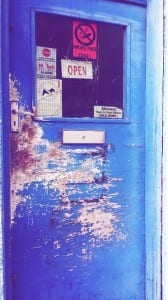 (Jeffs, 2015) fig.2
(Jeffs, 2015) fig.2
We suddenly realised that over time this park has changed, as it’s not how it used to be, this is when we realised a performance piece on time and using the park to do an instalment of some sort would be a better idea than poverty.
Our next task from Karen was to try and test out the recordings, so that we could get used to using the recorders and get a better idea of what places were ideal to record. We decided to test many different sounds and places, we recorded outside to get more of a raw, ambient sort of sound, but as it was so windy, the audio would just crackle and you wouldn’t be able to hear the audio properly. Taking this into account we tried to cover the microphone with a special microphone cover or, if that was still badly recorded we would try and gather around the mic with our jackets to block out the wind, just to try a few different techniques when recording.
Not only our voices but a piano tune too, we played a piano in a quiet room to try and see how well the microphone would pick up the piano, but as it was quite an echoed room we still couldn’t get the right sort of sound we wanted for our audio. Karen also thought it would be a good idea for our group to draw a map of how our audience members could get to the site, so that it could help our development process.
Now that we had our finalised idea – time, we all sat down and thought about the different ways we could portray the changing of time in this park. We decided our next step would be to research into Blast Theory and look into the sort of performances they perform including audio. There was one performance that caught my eye, ‘Fixing point’, it was a performance based on audio and having to listen so that you were part of the journey.
As we were trying to take our audience on a journey as well, we read up about the performance and tried to see if we could do something similar with our audio. We decided the only way to add to the performance, was to not only take them on an audio journey, but perhaps a visual journey too. Using this idea, we chose to record our walk to the park on a gopro camera, so the idea was that the audience member would walk to our site with a tablet and watch the video whilst they listened to our audio journey as well, to make it more interesting and diverse. “I faced the outside world with only the handheld computer Blast Theory had provided.” (Adams, 2003) As Blast Theory was our main influence we liked how an audience member was made to just take the tablet and go out into the performance by themselves without any help from the performers themselves, so we tried to incorporate this into our own performance by using a tablet or “Handheld computer”. (Adams, 2003)
The next step was to research more into the changing of time in Lincoln and its interesting history. We started to look into YouTube clips of past Lincoln and see what sort of information we could find, that perhaps we could use in our audio. Whilst looking, we found an interesting clip of an old lady named Margret and her experiences of growing up in Lincoln, we decided to try and include this in our audio as it was just what we were looking for (https://www.youtube.com/watch?v=b43j1HkNMvY). We also found another interesting piece of audio of a man talking about the history of Lincoln and what’s around us today. (https://www.youtube.com/watch?v=fNKuYdFAuAY)
The next challenge was obviously to edit the pieces of audio that we had previously found.
Whilst we were editing the audio we had already found, we thought about the different sound effects and music we could use for our journey. As our journey at this point was mainly based around the children of Lincoln and how it used to be and it is centred on an abandoned children’s park, we started thinking about children laughing, nursery rhymes and certain other sound effects. I decided to ask some people what sort of music/sound effects they would want to hear on a radio play. They said what would keep them interested would be a variety of different sound effects and only a little bit of music as otherwise it would take away from the story line. We definitely took this into consideration for our journey and started to experiment with some sound effects and recordings whilst we were editing.
We needed to test our idea of the use of chalk on the parks floor, so that we could see if it was as effective as we had hoped.
Buying some children’s chalk, we then went to our site and drew all over the floor, anything we could think of that related to our instalment, just to test it and see if it worked. Whilst we were at the site we took a microphone with us, so that we could record some ambient noise as background for our audio. We also tried to use a repetitive action at the site and record that, so that it’s similar to the repetitive actions that we would be doing in our final instalment. Drawing/writing, washing away, drawing and washing away etc.
On editing the audio, we collectively decided to write our own script and our feelings and thoughts on the past, present and future of Lincoln so that it would link in with our video of our journey. We all worked as a group and brought together some pieces of writing that we had done in our spare time, so that we could successfully write a long enough script to go together with the 20 minute video that we were currently recording. Whilst we were writing the script we were having several problems with the video footage, and we ended up changing the walk so that it was safer for our audience members. As the weather was torrential on a few occasions, when we would try to record the video it wouldn’t come out probably because of the weather conditions, or some people would get too close to the camera, so we would have to keep re-recording it. We ended up recording the journey 6 or 7 times until we got the final product, which we then continued to edit so it would fit with the audio we had made.
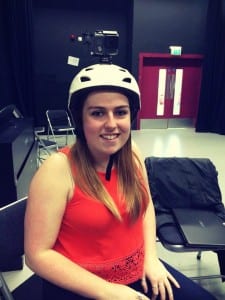 (Jeffs, 2015) fig.6
(Jeffs, 2015) fig.6
The next part of our process was to start recording the audio with all of us, as part of the audio itself. Taking the script that we had all written, we tried to find the best place to record, as some places would have an echoed background to them, we needed a solid and clear recording so that we would have the best quality of audio for our piece. On finding a quiet, enclosed room in one of the buildings of the university we managed to find the perfect sound for our audio. It didn’t have an echo and was clear for our audience members to hear, we each recorded a specific part of the script so that we could all have a part in the audio and worked as a team to ensure the audio was the best it could be at this point.
As previously mentioned Blast Theory did a piece called ‘Fixing point’, all about a murdered Irishman called Seamus Ruddy who was a politician, but gave up politics and moved to France to start a new life, away from the hold of politics. He was murdered by the Irish National Liberation Army in Paris, where he lived. The point of the performance (audio tour) was to understand more about Seamus’ life and how he went missing, and as part of the performance you would have to take a tablet and headphones into the woods and try and find Seamus, as his body in real life was never actually found. This was to show what was happening around the time of 1985 and how people would go missing, be murdered and their bodies would never be found. “Blast theory is renowned internationally as one of the most adventurous artists’ groups using interactive media.” (Blast theory, 2015)
The collaboration of the video and audio together was our next, toughest challenge of the process. We spent hours trying to get the right parts of the audio to fit with the journey of the video, as there were specific parts of the audio that mentioned certain parts of the walk – in the high street for example. We also had to cut parts of the audio together, so they would flow properly. Trying to cut different parts of the audio together and embedding an assortment of the YouTube videos I previously mentioned, we finally managed to get the audio and video sorted after a long night of work.
As the main element of our performance was the journey through the visual and audio, we came up with the idea of making our own blog which was separate to the group blog, as originally our idea was to have the video of our journey on the blog and any audience member would have to watch it before the performance date, so we decided to make a visual blog and poster, you can see the video of our journey through this link. (https://yourjourneylincoln.wordpress.com/).
Our final rehearsal and the final part of our process was to test our whole instalment at the park, ready for our final performance on May 7th. As our idea was to draw with chalk and wash it away straight after, we felt it would only work if we made sure that it was an effective method for our performance. We took a few buckets, brushes and spray bottles full of water so that we could test the act of washing away the drawings. It was extremely effective, better than we could’ve hoped for.
Performance Evaluation
On the day of our performance, it was torrential rain all day, and as our performance was outside we thought this might ruin our instalment, especially as we were drawing chalk on the floor and wanted to wash it off manually, not accidentally by the rain. Luckily, on the morning of our performance we tested the chalk on the wet floor of the park and if anything, the chalk worked better than when the floor of the park was dry, for us, the rain worked in our advantage. Performing to only Karen and Conan on the day we had an idea of giving the audience members a box of chalk each and getting them to write the first thing that came into their heads when they initially saw the park for the first time. They both happily participated and drew a few stickmen playing, an outline of their hands and the words ‘abandon this place’. We decided to perform our piece in complete silence, as if to show the silence of changing in time, when you don’t notice things have changed. They got to the park and we silently held a piece of paper up saying; “Draw what you think of when you first saw this park?” and continued to hand them the chalk over in silence. My role was to slowly wash away a part of the chalk we had drawn in the park and as soon as I had finished a section, I would run off to the hopscotch and do that action to show the repetitiveness of time. For example, the repeating of a ticking clock as time passes.
I continued to repeat this action until the performance ended, where we all froze ready for our feedback.
I think if we had to do the performance again or on a wider scale, we would alter the audio slightly and make sure that the video could be heard over the passing traffic as the audience members walked to the site. I also think, an interesting twist would be for us to watch the audience members drawing the pictures/words on the floor of the park rather than them watching us, to make it slightly more diverse and breaking the fourth wall with the audience. This performance made me realise that working with audio can be more effective than just a normal performance, also how you can transform an abandoned park into an interesting instalment. This whole experience has made me realise that you can make a really interesting and diverse performance anywhere, even if it is the most dingy, abandoned place. “Its location can work at a potent mnemonic trigger, helping to evoke specific past times related to the place and time of performance…” (Pearson, 2010)
(Jeffs, 2015) fig.11
Word count – 3063
References:
Adams, K. (2003) The Threshold of the real: A site for Participatory Resistance in Blast Theory’s Uncle Roy All around You. (Blackboard reading)
Blast Theory. (2015) Blast Theory. [Online] Brighton: Blast Theory. Available from http://www.blasttheory.co.uk [Accessed 14 May 2015]
Blast Theory. (2011) Fixing Point. [Online] Brighton: Blast Theory. Available from http://www.blasttheory.co.uk/projects/fixing-point/ [Accessed 13 May 2015]
British Pathe. (2014) City of Lincoln (1935). [Online] Lincoln: British Pathe. Available from http://www.youtube.com/watch?v=fNkUyDFAuAY [Accessed 13 May 2015]
Campbelltown life story circles. (2013) Margret – Lincoln UK growing up. [Online] Lincoln: Available from http://www.youtube.com/watch?v=b43j1HkNMvY [Accessed 13 May 2015]
Kaye, N. (2000) Site-specific art: Performance, Place and documentation. [Online] London: Routledge. Available from http://www.lib.myilibrary.com.proxy.library.lincoln.ac.uk/open.aspx?id=32715 [Accessed 15 May 2015]
Pearson, M. (2010) Site Specific Performance. Basingstoke: Palgrave Macmillan.
Smith, P. (2010) A guide to walking sideways. Devon: Triarchy Press.
yOUR Journey. (2015) yOUR interactive Journey. [Blog entry] 7 may. Lincoln: yOUR Journey. Available from http://www.yourjourneylincoln.wordpress.com [Accessed 13 May 2015]
Figure 1 – 10 (Jeffs, 2015)
